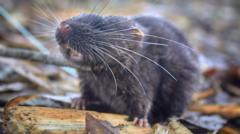The recent scientific expedition in Alto Mayo, Peru, led by Conservation International alongside local Indigenous groups, has resulted in the thrilling discovery of 27 new species, including an amphibious mouse with webbed feet and an unusual blob-headed fish. This initiative underscores the significance of both biodiversity and the growing pressures from human activity on these unique ecosystems.
Alto Mayo, regarded as a protected area within the Amazon rainforest, features diverse ecosystems and Indigenous territories. However, this region also faces substantial environmental pressures due to deforestation and agricultural development, as noted by Conservation International. Trond Larsen, the senior director of the organization, expressed awe at the discovery of such a variety of mammals and vertebrates, particularly in a landscape heavily influenced by human activities.
Among the notable discoveries are a new species of dwarf squirrel measuring just 14 cm, numerous types of fish, three amphibians, and 10 butterfly species. The expedition's findings also included the identifications of a new species of spiny mouse, known for its stiff guard hairs likened to hedgehog spines. Additionally, the indigenous Awajún community's extensive traditional ecological knowledge played a critical role. Yulisa Tuwi, an Awajún researcher, shared that this information empowers their community to safeguard their culture and natural resources.
Some species, although new to the scientific community, were already known to the indigenous populations. For instance, the blob-headed fish, marked by a significantly enlarged head, surprised scientists with its distinctive appearance.
While the announcement celebrates remarkable findings, it also serves as a reminder of the ongoing struggle to maintain environmental integrity in areas like Alto Mayo, where traditional lifestyles and habitats are increasingly at risk. The close collaboration between conservationists and the Indigenous Awajún people exemplifies a holistic approach to biodiversity protection and cultural preservation.
Alto Mayo, regarded as a protected area within the Amazon rainforest, features diverse ecosystems and Indigenous territories. However, this region also faces substantial environmental pressures due to deforestation and agricultural development, as noted by Conservation International. Trond Larsen, the senior director of the organization, expressed awe at the discovery of such a variety of mammals and vertebrates, particularly in a landscape heavily influenced by human activities.
Among the notable discoveries are a new species of dwarf squirrel measuring just 14 cm, numerous types of fish, three amphibians, and 10 butterfly species. The expedition's findings also included the identifications of a new species of spiny mouse, known for its stiff guard hairs likened to hedgehog spines. Additionally, the indigenous Awajún community's extensive traditional ecological knowledge played a critical role. Yulisa Tuwi, an Awajún researcher, shared that this information empowers their community to safeguard their culture and natural resources.
Some species, although new to the scientific community, were already known to the indigenous populations. For instance, the blob-headed fish, marked by a significantly enlarged head, surprised scientists with its distinctive appearance.
While the announcement celebrates remarkable findings, it also serves as a reminder of the ongoing struggle to maintain environmental integrity in areas like Alto Mayo, where traditional lifestyles and habitats are increasingly at risk. The close collaboration between conservationists and the Indigenous Awajún people exemplifies a holistic approach to biodiversity protection and cultural preservation.


















